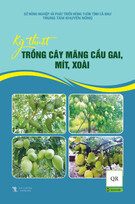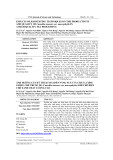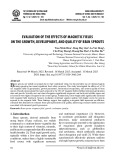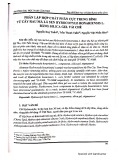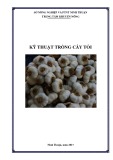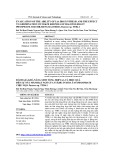
44 Nong Lam University, Ho Chi Minh City
The Journal of Agriculture and Development 23(Special issue 1) www.jad.hcmuaf.edu.vn
Effects of microbial organic fertilizer on glycoalkaloid content and yield of Solanum
procumbens Lour.
Lieu T. T. Nguyen*, Thuy T. Dao, Dan T. Vo, & Tri M. Bui
Faculty of Agronomy, Nong Lam University, Ho Chi Minh City, Vietnam
ARTICLE INFO ABSTRACT
Research Paper
Received: August 31, 2024
Revised: October 15, 2024
Accepted: October 17, 2024
Keywords
Glycoalkaloid content
Microbial organic fertilizer
Solanum procumbens Lour.
Weight
Yield
*Corresponding author
Nguyen Thi Thuy Lieu
Email:
nguyenlieuqn@hcmuaf.edu.vn
Solanum procumbens Lour. is a traditional medicinal plant known
for its rich glycoalkaloid content. This research aimed to determine
the suitable types and application rates of microbial organic
fertilizers to enhance yield and glycoalkaloid content in Solanum
procumbens Lour. A two-factor experiment was conducted using
a Split-Plot Design (SPD) with three replications. The main plots
included four types of microbial organic fertilizers (HD301,
HD302, Komix-BL2, and HCMK7), while the sub-plots involved
three application rates (2, 4, and 6 tonnes/ha per crop). Various
parameters were measured, including fresh and dry biomass
per plant, fresh and dry yield per ha, glycoalkaloid content, and
glycoalkaloid yield across two cropping cycles. The results indicated
that applying HCMK7 at a rate of 6 tonnes/ha per crop produced
the highest outcomes: in the initial crop, a fresh weight of 255.2 g
and dry weight of 111.1 g per plant, fresh yield of 15.77 tonnes/ha,
dry yield of 6.99 tonnes/ha, glycoalkaloid content of 0.70%, and
glycoalkaloid yield of 48.97 kg/ha. In the ratoon crop, the same
application rate yielded a fresh weight of 282.5 g and dry weight
of 134.6 g/plant, fresh yield of 17.62 tonnes/ha, dry yield of 9.21
tonnes/ha, glycoalkaloid content of 0.76%, and glycoalkaloid yield
of 70.39 kg/ha. The highest average glycoalkaloid content (0.73%)
and total glycoalkaloid yield (119.36 kg/ha) across both crops were
also recorded at this application rate.
Cited as: Nguyen, L. T. T., Dao, T. T., Vo, D. T., & Bui, T. M. (2024). Effects of microbial organic
fertilizer on glycoalkaloid content and yield of Solanum procumbens Lour. The Journal of Agriculture
and Development 23(Special issue 1), 44-55.

Nong Lam University, Ho Chi Minh City 45
The Journal of Agriculture and Development 23(Special issue 1) www.jad.hcmuaf.edu.vn
organic fertilizers could positively impact the
yield and glycoalkaloid content of Solanum
procumbens Lour.
2. Materials and Methods
2.1. Materials
Solanum procumbens Lour. seeds (sample
code QN9) were collected from Duc Pho
district, Quang Ngai province, Vietnam, and
subsequently planted at the Agronomy Research
Station of Nong Lam University, Ho Chi Minh
City, Vietnam. The seeds were sown in a nursery
using a growth medium composed of 60% grey
soil, 29% cow manure, 1% superphosphate, and
10% rice husk ash, and were allowed to grow for
60 days. Once the seedlings reached a height
of 5 - 6 cm, developed 5 - 6 leaves, and were
observed to be free of diseases and pests, they
were transplanted into the field.
The microbial organic fertilizers used in this
experiment were as follows:
HD301: Containing 0.5% nitrogen, 0.5%
P2O5, 0.5% K2O, 15% organic matter, and
Trichoderma sp. at a density of 1.2 x 106 CFU/g.
HD302: Containing 1% nitrogen, 1% P2O5,
1% K2O, ≥ 15% organic matter, and Hirsutella sp.
at a density of 106 CFU/g.
Komix-BL2: Containing 1% nitrogen, 3%
P2O5, 1% K2O, 1% Mg, 100 ppm Zn, 200 ppm
Mn, 16% organic matter, 30% humidity, and
phosphate-solubilizing microorganisms at a
density of ≥ 1 x 106 CFU/g.
HCMK7: Containing 18% organic matter,
2% nitrogen, 2% P2O5, 1% K2O, trace elements
(CaO, MgO, B, Cu, Zn), and Trichoderma sp. at a
density of 106 CFU/g.
1. Introduction
Solanum procumbens Lour. is a traditional
medicinal plant in Vietnam, known for its rich
content of glycoalkaloids and other secondary
metabolites, including cholesterol, β-sitosterol,
lanosterol, dihydrolanosterol, and solasodine,
which offer various health benefits. This plant
has been shown to have properties that prevent
cirrhosis, reduce inflammation, and protect
the liver (Nguyen, 2002; Huynh et al., 2021).
Solanum procumbens Lour. thrives in areas
with adequate sunlight (Do, 2004), making the
Southeast of Southern Vietnam an ideal region
for its cultivation, where it also shows an increase
in glycoalkaloid content.
In agricultural production, chemical fertilizers
are commonly used due to their ability to quickly
increase productivity at a low cost. However,
the use of chemical fertilizers in long term can
lead to imbalances soil pH, reduced bacterial
diversity and major changes in the composition
of the bacterial population (Wu et al., 2020).
On the other hand, microbial organic fertilizers
improve soil fertility by increasing humus and
organic matter content, and by optimizing the
function of soil microbial populations (Zhu et
al., 2021). For grey degraded soils, which have
lower clay and organic matter content, microbial
organic fertilizers should be added to improve
soil fertility and physical properties. Research
has shown that microbial organic fertilizers can
increase herb yield, seed weight, and essential oil
content in medicinal plants, while also enhancing
their resistance to diseases and pests (Wang et
al., 2019; Huang et al., 2022). Furthermore, these
fertilizers have been demonstrated to boost the
synthesis and accumulation of active secondary
metabolites such as organic acids, saponins,
alkaloids, sesquiterpenes, and lactones (Waqas et
al., 2015). Therefore, the application of microbial

46 Nong Lam University, Ho Chi Minh City
The Journal of Agriculture and Development 23(Special issue 1) www.jad.hcmuaf.edu.vn
The experiment was conducted at Agronomy
Research Station in Nong Lam University, Ho
Chi Minh City, Vietnam from June 2021 to
March 2022
Solanum procumbens Lour. were transplanted
during the rainy season in 2021, a period
favorable for the growth and development of
the plant. However, the high rainfall during the
harvesting period posed challenges for drying
the fresh herbs. The ratoon crop was cultivated
during the sunny season, from November 2021
to March 2022. During this period, irrigation
was necessary to support the plants’ growth,
reproduction, and fruiting.
The data in Table 1 showed that cultivated
soil was a silty clay, moderately acidic, low
organic matter and total nitrogen but high total
phophorus and potassium (Rayment & Lyons,
2011). Available P2O5 and K2O were low.
Solasodine: made by Chengdu Biopurify
Phytochemicals Ltd.
2.2. Experiment design
A two-factor experiment was conducted
using a Split-Plot Design (SPD) with three
replications. The main plots were assigned four
types of microbial organic fertilizers (HD301,
HD302, Komix-BL2, HCMK 7), while the
subplots consisted of three fertilizer doses (2
tonnes/ha per crop, 4 tonnes/ha per crop, and 6
tonnes/ha per crop). The experiment was carried
out over two cropping cycles, with the same
fertilizer doses applied in both cycles. Solanum
procumbens Lour. planted at a spacing of 40 cm
× 30 cm, resulting in a plant density of 83,333
plants/ha. Each treatment was applied to a plot
size of 9.0 m² (6.0 m × 1.5 m). Microbial organic
fertilizers were applied 3 days before planting for
the initial crop and 7 days after harvesting for the
initial crop.
Table 1. Physical and chemical properties of the experimental soil
Texture (%) pHKCl Organic matter
(%)
Total N
(%)
Total P2O5
(%)
Total K2O
(%)
Clay Silt Sand
36.98 12.88 50.14 5.78 0.81 0.065 0.059 0.058
Source: Research Institute for Biotechnology and Environment, Nong Lam University (2021).
2.3. Data collection and statistical analysis
Fresh herb weight (g/plant): The fresh weight
of the herb was measured as the average stems,
leaves, flowers and fruits of 5 target plants at 135
days after transplantation for the initial crop and
124 days after cutting for the ratoon crop.
Dried herb weight (g): The dried weight of the
herb (g/plant) was calculated the average stems,
leaves, flowers and fruits of 5 target plants after
drying at 70°C until weight stability was achieved.
Actual fresh yield (tonnes/ha): This was
calculated using the formula: Actual fresh yield
(tonnes/ha) = The fresh herb weight of each
base plot (kg) x 10-3 × 10,000]/Area of the base
plot (m2).
Actual dry yield (tonnes/ha): This was
calculated at 8% herb moisture content using the
formula: Actual dry yield (tonnes/ha) = The dry
herb weight of each base plot (kg) x 10-3 × 10,000]/
Area of the base plot (m2) (was calculated at the
moisture content of herbs 8%).

Nong Lam University, Ho Chi Minh City 47
The Journal of Agriculture and Development 23(Special issue 1) www.jad.hcmuaf.edu.vn
drying residue at 50°C. Dissolving residue with
methanol, filtering and transfering to a 10 mL
graduated cylinder, adding methanol in enough
to make 10 mL of solution. This was test solution.
For the analysis of th glycoalkaloid content of
Solanum procumbens: 2 g herbal powder in each
treatment was extracted with 50 mL methanol-
acetic acid solution 5% in 3 h. Filtering and
Table 2. Chemicals and amount of chemicals in samples
Reagents Standard sample Test sampsle White sample
Buffer solution pH8 5.0 5.0 5.0
Bromothymol blue solution 2% 0.5 0.5 0.5
Standard solasodine solution (0.5 mg/mL) 0.5 0.0 0.0
Test solution 0.0 0.5 0.0
Methanol 0.0 0.0 0.5
Chloroform 10.0 10.0 10.0
To shake for 5 min
To transfer chloroform into other tube after
30 min
To shake chloroform with 10 mL NaOH 0.05
N solution
To transfer blue solution into other tube after
30 min
To measure the absorbance of blue solution at
a wavelength of 616 nm
Glycoalkaloid content was calculated using
the following formula:
X (%) = [DT x 50]/[Dc x a x (100 - A]
Where:
Dc: absorbance value of the standard sample
at a wavelength of 616 nm
DT: absorbance value of the test sample at a
wavelength of 616 nm
a: dried herb weight
A: Herb moisture content (Nguyen &
Pham, 2000)
Glycoalkaloid yield (kg/ha): This was
calculated using the formula:
The glycoalkaloid yield (kg/ha) = Actual
harvested dried yield (tonnes/ha) x glycoalkaloid
content (%)] x 1000/100
The total glycoalkaloid yield (kg/ha) was
calculated as the sum of the glycoalkaloid yields
from both the initial crop and the ratoon crop.
Economic analysis:
+ Total cost (VND/ha per crop): This was
calculated by summing general costs (seeds,
labor, other materials) and microbial organic
fertilizer costs.
+ Production cost (VND/kg glycoalkaloid):
This was calculated using the formula:Production
cost (VND/kg glycoalkaloid) = The glycoalkaloid
yield (kg/ha)/Total cost (VND/ha per crop)
Data analysis: Data were analyzed using
DSAASTAT software. Differences between
treatments were tested using Duncan’s Multiple
Range Test at a significance level of 0.05 or 0.01.

48 Nong Lam University, Ho Chi Minh City
The Journal of Agriculture and Development 23(Special issue 1) www.jad.hcmuaf.edu.vn
Data in Table 4 showed that the actual fresh
yields in both the initial and ratoon crops
were significantly influenced by the amounts
of microbial organic fertilizers applied, with
statistically significant differences observed. The
highest actual fresh yields were obtained with
the application of 6 tonnes/ha per crop, reaching
13.88 tonnes/ha in the initial crop and 16.48
tonnes/ha in the ratoon crop. The differences
in the effects of the types of microbial organic
fertilizers on actual fresh yield in the ratoon
crop were not statistically significant. Both the
type and amount of microbial organic fertilizers
applied had a significant impact on the actual dry
yield in both cropping cycles. The highest actual
dry yield was achieved with the application of
HCMK7 fertilizer, yielding 5.98 tonnes/ha in
the initial crop and 7.72 tonnes/ha in the ratoon
crop. Significant differences in actual dry yield
were also observed across different fertilizer
application rates. The application of 6 tonnes/ha
per crop resulted in the highest actual dry yield,
with 6.06 tonnes/ha in the initial crop and 8.27
tonnes/ha in the ratoon crop, both of which were
statistically significant (P < 0.01). In contrast,
the application of 2 and 4 tonnes/ha per crop
resulted in lower actual dry yields in both crops
HCMK7 application in the ratoon crop (P <
0.05). Additionally, the highest dried herb weight
was achieved with the highest dose of microbial
organic fertilizer (6 tonnes/ha per crop, P < 0.01).
The microbial organic fertilizers contain
organic matter, N, P2O5, K2O, and effective
microorganisms. These fertilizers supply essential
nutrients and beneficial microorganisms that
enhance soil health and crop growth (Wei et al.,
2024). Therefore, applying microbial organic
fertilizers with higher nutrient content and in
larger amounts increased the fresh and dried
herb weight of Solanum procumbens Lour.
3. Results and Discussion
3.1. Effect of microbial organic fertilizers on
yield components, herb yield, glycoalkaloid
content, and glycoalkaloid yield of Solanum
procumbens Lour.
The types of microbial organic fertilizers
applied had a statistically significant effect on the
fresh herb (Table 3). When HCMK7 was used in
the initial crop, the fresh herb weight of Solanum
procumbens was highest, showing a statistically
significant difference compared to the fresh herb
weight when HD301 and HD302 (P < 0.01)
applications. In the ratoon crop, the differences
in fresh herb weight between treatments were
not statistically significant (P > 0.05).
Regarding the amount of microbial organic
fertilizer applied, both cropping cycles showed
that applying 6 tonnes/ ha per crop resulted in a
statistically significantly higher fresh herb weight
compared to the 2 and 4 tonnes/ha per crop
treatments (P < 0.01). The HCMK7 fertilizer,
which contains 2% nitrogen, positively impacted
the growth of Solanum procumbens Lour. and
enhanced fresh herb weight. This finding aligns
with results from Pham et al. (2019) and Le et al.
(2020), who reported that the fresh herb weight
of Solanum procumbens Lour. was highest with
the application of 250 kg N/ha per year or 125 kg
N/ha per crop. It is also consistent with Hoang
et al. (2016), who observed increased fresh herb
weight in Solanum procumbens Lour. with the
application of 250 kg N + 200 kg P2O5 + 150 kg
K2O compared to other fertilizer rates.
Significant differences in dried herb weight
were also observed between treatments in both
the initial and ratoon crops. The highest dried
herb weight was noted with HCMK7 application
in the initial crop (P < 0.05), while higher dried
herb weights were found with Komix-BL2 and



